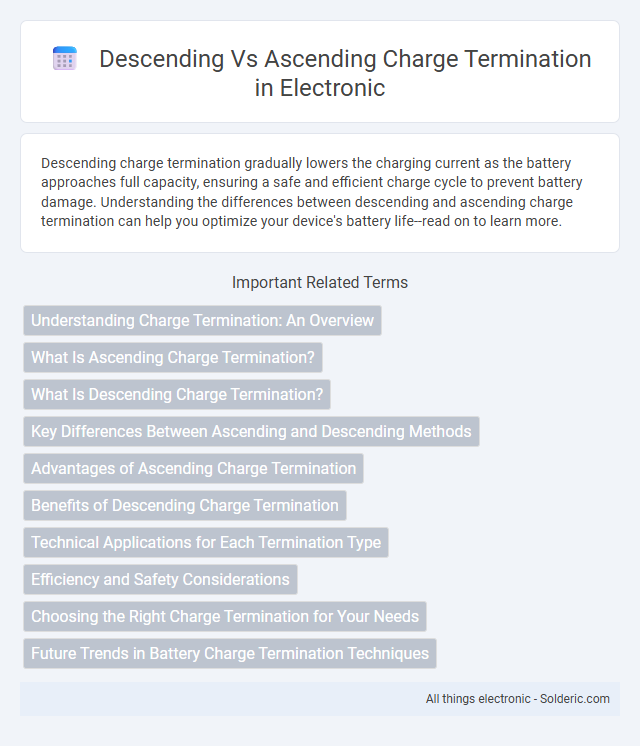Descending charge termination gradually lowers the charging current as the battery approaches full capacity, ensuring a safe and efficient charge cycle to prevent battery damage. Understanding the differences between descending and ascending charge termination can help you optimize your device's battery life--read on to learn more.
Comparison Table
| Feature | Descending Charge Termination | Ascending Charge Termination |
|---|---|---|
| Definition | Charge stops when current decreases below a set threshold. | Charge stops when voltage rises above a set threshold. |
| Trigger Parameter | Charging current drop | Battery voltage level |
| Use Case | NiMH, NiCd batteries; constant voltage charging | Lead-acid, Lithium-ion batteries; constant current charging |
| Accuracy | Highly accurate in detecting full charge | Moderate accuracy, may overcharge if threshold not optimized |
| Battery Life Impact | Better protection against overcharging | Risk of overcharging if voltage threshold miscalculated |
| Complexity | Requires current monitoring circuitry | Voltage monitoring only; simpler implementation |
| Common Applications | Smart chargers, portable devices | Automotive batteries, stationary storage |
Understanding Charge Termination: An Overview
Charge termination in descending and ascending types refers to the direction in which electrical charge is dissipated or neutralized within a system. Descending charge termination typically involves grounding mechanisms that direct charge downward into the earth, effectively neutralizing static or excess electrical energy. Ascending charge termination directs charge upwards or away from sensitive components, often using capacitive or insulating materials to prevent electrical discharge and maintain system stability.
What Is Ascending Charge Termination?
Ascending charge termination is a battery charging method where the charging current gradually increases from a low to a higher value as the battery approaches full charge, optimizing energy efficiency and battery lifespan. This technique allows precise control over the charging process by monitoring battery voltage and temperature, reducing the risk of overheating or overcharging. It is commonly used in lithium-ion and nickel-metal hydride battery management systems to enhance charging performance and ensure safety.
What Is Descending Charge Termination?
Descending charge termination refers to the process of completing a financial obligation by making payments starting from the highest charge or balance first, gradually moving down to smaller amounts. This method helps prioritize larger debts, potentially reducing interest accrual on significant balances quicker than other strategies. Choosing descending charge termination can optimize your debt repayment efficiency and manage your overall financial burden more effectively.
Key Differences Between Ascending and Descending Methods
Descending charge termination involves releasing charge starting from the highest level and moving downward, while ascending charge termination begins at the lowest charge level and progresses upward. This key difference affects energy efficiency and device longevity, as descending methods often prevent overcharging by cutting off at a predetermined higher threshold. Your battery management system's choice between ascending or descending termination impacts overall charging speed and safety protocols.
Advantages of Ascending Charge Termination
Ascending charge termination enhances battery longevity by preventing over-discharge and ensuring consistent voltage cutoff during discharge cycles. This method improves safety by reducing the risk of deep discharge, which can damage battery cells or cause thermal runaway. It also optimizes battery performance by maintaining a stable energy output, resulting in more efficient power management.
Benefits of Descending Charge Termination
Descending charge termination improves device reliability by minimizing oxide stress and reducing breakdown risk during high-voltage switching. This method ensures a more uniform electric field distribution, enhancing the longevity of semiconductor components. Your circuits benefit from better performance stability and extended operational lifespan with descending charge termination.
Technical Applications for Each Termination Type
Descending charge termination is commonly applied in high-voltage equipment to prevent electrical discharges by directing charge away from critical components, enhancing insulation reliability in transformers and capacitors. Ascending charge termination finds use in semiconductor devices and integrated circuits, where controlling charge drift upward improves signal integrity and reduces leakage currents. Your choice between these termination types should align with the specific electrical and mechanical requirements of your technical application to optimize performance and durability.
Efficiency and Safety Considerations
Descending charge termination enhances efficiency by enabling faster discharge rates, reducing energy losses in battery systems. Safety considerations prioritize ascending charge termination to prevent thermal runaway and ensure stable voltage gradients during device operation. Optimal performance often requires balancing descending discharge efficiency with ascending charge safety protocols in energy storage management.
Choosing the Right Charge Termination for Your Needs
Choosing the right charge termination depends on your specific device requirements and operational environment, with descending charge termination reducing charge current incrementally to avoid overcharging, while ascending charge termination gradually increases current to reach optimal charge levels. Efficient battery management relies on understanding these methods to maximize battery life and performance, especially in applications where precision charging is critical. Your choice impacts battery longevity, safety, and overall device efficiency, making tailored charge termination an essential factor in power management strategies.
Future Trends in Battery Charge Termination Techniques
Future trends in battery charge termination techniques emphasize adaptive algorithms that optimize charge end-points, improving both safety and battery lifespan. Descending charge termination methods are evolving to integrate real-time data analytics and machine learning, enabling precise detection of full charge states and minimizing overcharge risks. Ascending charge termination approaches increasingly leverage smart sensors and IoT connectivity to enhance energy efficiency and promote sustainable battery management in advanced energy storage systems.
Descending vs Ascending charge termination Infographic

 solderic.com
solderic.com